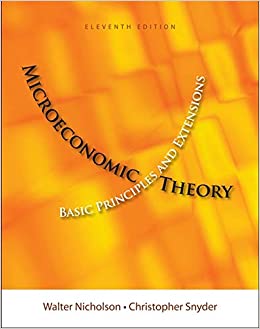
Microeconomic Theory 11th Edition by Walter Nicholson,Christopher Snyder
Edition 11ISBN: 978-1111525538
Microeconomic Theory 11th Edition by Walter Nicholson,Christopher Snyder
Edition 11ISBN: 978-1111525538 Exercise 4
Suppose that Robinson Crusoe produces and consumes fish (F) and coconuts (C). Assume that, during a certain period, he has decided to work 200 hours and is indifferent as to whether he spends this time fishing or gathering coconuts. Robinson's production for fish is given by

and for coconuts by

where lF and lC are the number of hours spent fishing or gathering coconuts. Consequently,

Robinson Crusoe's utility for fish and coconuts is given by

a. If Robinson cannot trade with the rest of the world, how will he choose to allocate his labor? What will the optimal levels of F and C be? What will his utility be? What will be the RPT (of fish for coconuts)?
b. Suppose now that trade is opened and Robinson can trade fish and coconuts at a price ratio of p F /p C = 2/1. If Robinson continues to produce the quantities of F and C from part (a), what will he choose to consume once given the opportunity to trade? What will his new level of utility be?
c. How would your answer to part (b) change if Robinson adjusts his production to take advantage of the world prices?
d. Graph your results for parts (a), (b), and (c).

and for coconuts by

where lF and lC are the number of hours spent fishing or gathering coconuts. Consequently,

Robinson Crusoe's utility for fish and coconuts is given by

a. If Robinson cannot trade with the rest of the world, how will he choose to allocate his labor? What will the optimal levels of F and C be? What will his utility be? What will be the RPT (of fish for coconuts)?
b. Suppose now that trade is opened and Robinson can trade fish and coconuts at a price ratio of p F /p C = 2/1. If Robinson continues to produce the quantities of F and C from part (a), what will he choose to consume once given the opportunity to trade? What will his new level of utility be?
c. How would your answer to part (b) change if Robinson adjusts his production to take advantage of the world prices?
d. Graph your results for parts (a), (b), and (c).
Explanation
(a)
Only two goods are produced in an ec...
Microeconomic Theory 11th Edition by Walter Nicholson,Christopher Snyder
Why don’t you like this exercise?
Other Minimum 8 character and maximum 255 character
Character 255


